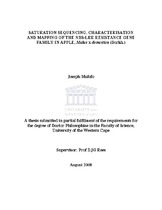| dc.contributor.advisor | Rees, D.J.G. | |
| dc.contributor.author | Mafofo, Joseph | |
| dc.contributor.other | | |
| dc.contributor.other | Faculty of Science | |
| dc.date.accessioned | 2014-02-07T12:03:59Z | |
| dc.date.available | 2010/03/31 02:53 | |
| dc.date.available | 2010/03/31 | |
| dc.date.available | 2014-02-07T12:03:59Z | |
| dc.date.issued | 2008 | |
| dc.identifier.uri | http://hdl.handle.net/11394/2788 | |
| dc.description | Philosophiae Doctor - PhD | en_US |
| dc.description.abstract | To date five classes of resistance proteins have been identified in plants and these include the intracellular protein kinases, receptor-like protein kinases with extracellular leucinerich repeat (LRR) domain, LRR proteins that encode membrane bound extracellular proteins, toxin reductase and intracellular LRR proteins with a nucleotide-binding site (NBS). These proteins recognise "invading pathogen" and in turn trigger defence response systems that act to protect plants from invading pathogens. The NBS-LRR genes which constitutes the major class encode a family of resistance proteins that are made up of a centrally located nucleotide binding site domain and a C-terminal leucine rich repeat receptor. This class of genes constitute the largest family of resistance genes identified in plants to date. They make up the majority of proteins involved in the plant basal and inducible defence systems against pathogen infection. | en_US |
| dc.language.iso | en | en_US |
| dc.publisher | University of the Western Cape | en_US |
| dc.subject | Plants | en_US |
| dc.subject | Disease challenge | en_US |
| dc.subject | Plant resistance genes | en_US |
| dc.title | Saturation sequencing, characterisation and mapping of the NBS-LRR resistance gene family in apple, Malus x domestica (Borkh) | en_US |
| dc.type | Thesis | en_US |
| dc.rights.holder | University of the Western Cape | en_US |
| dc.description.country | South Africa | |

